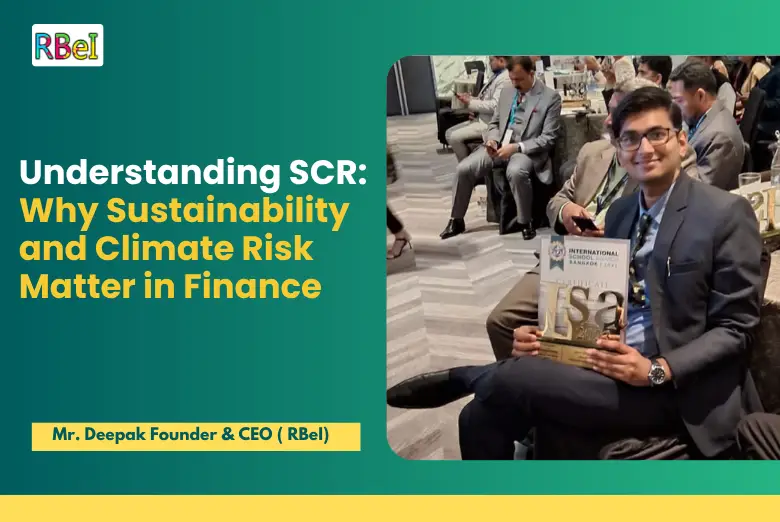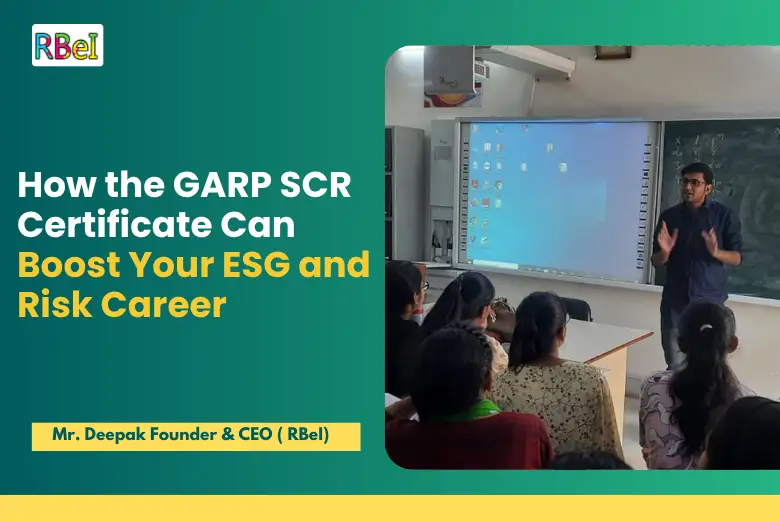Understanding SCR: Why Sustainability and Climate Risk Matter in Finance

In today’s evolving finance world, Sustainability and Climate Risk (SCR) have emerged as central themes, not just buzzwords. As more institutions, regulators, investors, and stakeholders emphasize responsible investing, sustainability and climate risk matter more than ever in finance. SCR concerns the integration of environmental sustainability and climate change considerations into financial decision-making, risk management, and capital allocation. In this blog, we’ll deeply explore: what SCR means, why it matters, how it is applied in finance, challenges, emerging trends, and what students and future finance professionals should know. By weaving in Sustainability and Climate Risk (SCR) early and often, this blog strives to give you both conceptual clarity and practical insights. What Is SCR? (Sustainability and Climate Risk) Defining SCR: Sustainability and Climate Risk “Sustainability and Climate Risk (SCR)” refers broadly to the risks, opportunities, and management practices associated with climate change, environmental degradation, and sustainable development goals as they intersect with finance and economics. Sustainability typically refers to meeting present needs without compromising the ability of future generations to meet their own—covering environmental, social, and governance (ESG) considerations. Climate risk refers to the financial risks arising from climate change—both the physical risks (storms, floods, heat waves, sea-level rise) and transition risks (policy changes, technological disruption, shifts in consumer preferences). Combined, Sustainability and Climate Risk (SCR) deals with embedding climate and sustainability factors into financial analysis, risk management frameworks, capital allocation, regulation, reporting, and strategy. When we speak of “SCR in finance,” we mean how financial institutions, investors, corporations, and regulators factor in climate-related uncertainties and sustainable development into financial decisions. SCR vs ESG: How They Relate and Differ While SCR overlaps with ESG (Environmental, Social, Governance), it has a distinct focus: ESG is broader: it includes social and governance issues (labor practices, human rights, board diversity, etc.). The “E” in ESG covers environmental issues, including climate. SCR narrows more tightly on sustainability + climate dynamics—emphasizing climate risk, transition strategy, long-term resilience, nature risk, carbon accounting, etc. In other words, SCR is like a focused subdomain within ESG / sustainable finance, devoted specifically to climate risk and sustainability strategies. Institutions like GARP (Global Association of Risk Professionals) now offer a SCR Certificate to equip professionals with competencies in sustainability and climate risk. Thus, when you see SCR, think: “the intersection of sustainability and climate risk applied in finance.” Why Sustainability and Climate Risk Matter in Finance: Key Drivers To answer “why SCR matters in finance,” we must explore several forces pushing the integration of sustainability and climate risk into financial systems. Here are the major drivers: 1. Escalating Physical Climate Risks Extreme weather events (storms, floods, droughts, wildfires), sea-level rise, heat stress, shifting precipitation patterns—all pose physical risks to assets, supply chains, infrastructure, and ecosystems. In finance, physical risks can translate into: Asset damage (e.g. real estate, power plants, transportation infrastructure) Business disruption (supply chain delays, reduced productivity) Insurance losses, increased claims, liability exposure Credit risk deterioration (borrowers affected by climate shocks may default) Hence, financial institutions must evaluate how portfolios will fare under more frequent and severe climate events. A recent review on financial climate risk highlights how the complexity of integrating climate science into risk frameworks is a key challenge. 2. Transition Risks and Policy Shifts Transition risk arises from shifts in policies, regulation, technology, market preferences, and investor sentiment as economies decarbonize. Examples include: Carbon pricing or tax implementation Stricter emissions regulations Mandated phase-outs of fossil fuels Technological disruption (e.g. renewable energy, battery tech) Market revaluation of “stranded assets” (e.g. coal reserves, non-compliant infrastructure) Financial firms that fail to anticipate transition risk may face sudden asset revaluations or stranded investments. 3. Regulatory and Disclosure Pressure Globally, regulatory bodies are increasingly mandating climate-related financial disclosures. For instance: The Task Force on Climate-related Financial Disclosures (TCFD) laid out a framework centered on governance, strategy, risk management, metrics & targets. Many jurisdictions (e.g. EU, UK) are moving toward mandatory disclosures aligned with TCFD or similar frameworks. Supervisory authorities are pushing banks, insurers, asset managers to integrate climate risk into capital planning and stress testing. Thus, financial firms cannot ignore SCR—compliance demands it. 4. Investor and Stakeholder Demands Investors—especially institutional investors, sovereign wealth funds, pension funds—are demanding that capital be directed toward sustainable and resilient ventures. They are incorporating ESG screens, sustainable mandates, and climate-themed products (e.g. green bonds). Stakeholders such as clients, regulators, civil society, millennials, and employees expect organizations to have credible sustainability and climate risk strategies. 5. Opportunity and Innovation SCR is not just about risk mitigation. It opens doors to: Sustainable financial products (green bonds, sustainability-linked loans, climate derivatives) Investment in climate solutions—renewables, energy efficiency, carbon capture, climate adaptation infrastructure Competitive advantage: firms with better SCR frameworks can win capital, reputation, regulatory favor Resilience: better positioning in a low-carbon, climate-resilient future Thus, SCR matters as both a defensive necessity and a proactive growth lever. 6. Systemic Risk and Financial Stability Climate change is not just an idiosyncratic risk—it is systemic. Because climate impacts are correlated (affecting multiple sectors, geographies, assets), they can threaten broader financial stability. Financial regulators and central banks are increasingly treating climate risk as a macroprudential concern. Deloitte emphasizes that sustainable finance and integration of climate risk must become engrained in day-to-day operations across financial services. Key Dimensions of SCR in Finance Understanding SCR in finance requires decomposing the subject into manageable dimensions. Below are essential building blocks. Physical Risk, Transition Risk & Liability Risk Physical Risk: Risks from climate hazards (floods, storms, drought). These risks may damage property, infrastructure, operations. Transition Risk: Risks from the shift to a low-carbon economy—policy, technology, market, legal shifts. Liability Risk: Potential for legal claims—companies may be held accountable for contributing to climate change, or for failing to mitigate risks. These three are core categories of climate risk in financial analysis. Scenario Analysis & Stress Testing To manage SCR, institutions use scenario analysis—projecting various climate futures (e.g. 1.5 °C, 2 °C, 3 °C warming) and assessing impacts on portfolios. Stress testing can simulate severe climate shocks, transition pressures,
How the GARP SCR Certificate Can Boost Your ESG and Risk Career

In today’s rapidly evolving financial landscape, professionals are increasingly expected to understand and manage sustainability and climate-related risks. The GARP SCR Certificate (Sustainability and Climate Risk) is a globally recognized credential that equips individuals with the knowledge and skills necessary to assess and mitigate these risks effectively. This certification is particularly valuable for those pursuing careers in ESG (Environmental, Social, and Governance) and risk management, as it demonstrates a commitment to sustainable practices and enhances professional credibility. Understanding the GARP SCR Certificate What is the GARP SCR Certificate? The GARP SCR Certificate gives professionals a comprehensive understanding of sustainability and climate risks and shows how these factors affect financial markets and institutions. Offered by the Global Association of Risk Professionals (GARP), this certification covers a range of topics, including climate science, risk assessment methodologies, and sustainable finance practices. Exam Structure and Content The SCR exam includes 80 multiple-choice questions and one case study, to be completed within four hours. It covers several key areas: The organization offers the exam twice a year—in April/May and October/November—and reserves appointments on a first-come, first-served basis. Benefits of the GARP SCR Certificate 1. Enhances Career Opportunities Holding the GARP SCR Certificate can significantly enhance your career prospects in the ESG and risk management sectors. It demonstrates a specialized understanding of sustainability and climate risks, making you a valuable asset to employers seeking professionals with expertise in these areas. 2. Provides a Competitive Edge In a competitive job market, possessing the SCR certification sets you apart from other candidates. It showcases your commitment to professional development and your ability to address complex challenges related to sustainability and climate risk. 3. Facilitates Career Transitions For professionals looking to transition into ESG or risk management roles, the GARP SCR Certificate serves as a credible credential that validates your knowledge and skills in these fields. It can open doors to new career paths and opportunities. 4. Expands Professional Network Becoming a GARP SCR certificate holder connects you with a global community of risk professionals and experts in the field. This network provides opportunities for collaboration, knowledge sharing, and career networking. Preparing for the GARP SCR Exam Study Materials and Resources To prepare effectively for the SCR exam, it’s essential to utilize comprehensive study materials and resources. GARP provides an official study guide and learning objectives that help candidates self-study for the exam. Additionally, the official SCR exam book includes 10 chapters with associated learning objectives and illustrative case studies. Study Plan and Strategies Developing a structured study plan is crucial for success in the SCR exam. Allocate sufficient time to cover all exam topics, focusing on areas where you may need additional review. Practice with sample questions and case studies to familiarize yourself with the exam format and improve your problem-solving skills. Exam Registration and Logistics To register for the SCR exam, visit the official GARP website and select your preferred exam date and location. Appointments are reserved on a first-come, first-served basis, so it’s advisable to register early. Career Paths with the GARP SCR Certificate Earning the GARP SCR Certificate can open doors to various career paths in the ESG and risk management sectors. Some potential roles include: These roles are in high demand across various industries, including banking, asset management, insurance, consulting, technology, and even non-financial sectors like fashion and hospitality. Conclusion The GARP SCR Certificate is a valuable credential for professionals seeking to enhance their careers in ESG and risk management. It provides a comprehensive understanding of sustainability and climate risks, equipping individuals with the knowledge and skills necessary to address these challenges effectively. By earning this certification, you demonstrate a commitment to sustainable practices and position yourself as a leader in the field of risk management.
